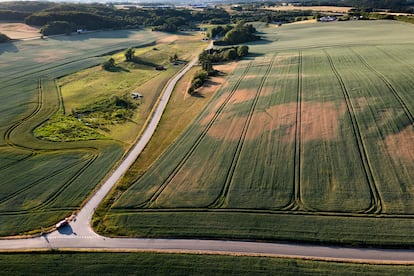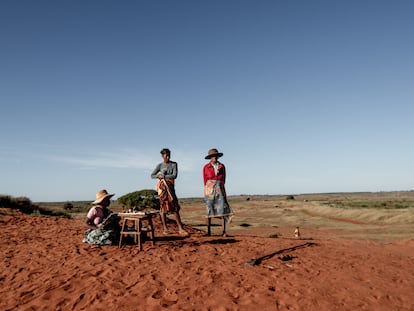Green Denmark turns yellow due to drought
Water scarcity, accentuated by climate change, is being felt in the fields of one of the wettest countries in Europe


In late June, the train ride between Copenhagen and Esbjerg was a very different experience from what the Danes are used to in early summer. The evergreen fields of the islands of Sjælland and Fyn and the Jutland peninsula were worryingly yellow after one of the driest springs in recent years — a far cry from the traditional, perpetually bucolic landscape of one of Europe’s wettest countries. Climate change is also being felt at these latitudes, where ever drier summers are predicted: it is as if the traveler had inadvertently moved a few hundred (or thousands) of kilometers to the south.
The severe lack of rain was only partially alleviated by the arrival of a timid front in the last few days — the first natural irrigation in weeks — and did not pose an immediate risk to crops or human consumption. But it is beginning to change some ancient customs, such as the recent midsommar festival, in which the Danes (and Scandinavians in general) celebrate the arrival of summer.
This year, with near-tropical daytime temperatures in several parts of the country — and in their Nordic neighbors — the scenes of glowing bonfires and barbecues in rural Denmark have been much less festive: several areas of the country have launched awareness campaigns, and even bans on burning, to prevent the festivities from turning into wildfires. These precautions have extended to Sweden, Denmark’s northeastern neighbor, where low rainfall was also the predominant note during the spring, with May 2023 being one of the driest on record. The drought, in this case, is resulting in small forest fires, a novelty in such northern latitudes as these.
Recent relief
“Climate change is causing droughts to become more severe and more frequent around the world. Even in a relatively cool and wet country like Denmark, we are seeing stronger episodes of this type,”Mikael Scharling, climatologist at the Danish Meteorological Institute (DMI), told EL PAÍS. The agency’s drought index reached more than 9 (on a scale of 10) between May 31 and June 25. Since then, recent rains have left a remarkable 55 liters per square meter (312 inches per square foot) in much of the country, which has restored some calm.
Although worrying, the current episode of drought in Denmark is still a far cry from the one it suffered five years ago: the summer of 2018 is an unhappy memory in virtually all Nordic countries. Then, the heavy accumulated losses — which the sector came to quantify at more than €1 billion (US$1.97 billion), at the current exchange rate — left some farmers on the verge of bankruptcy.
Large groundwater reserves
Today, despite three weeks without a drop of rain in late May and mid-June — something that had not happened since the two months without rain in 2018 — the situation is a long way from being as dramatic as it was then. As Simon Stisen, a hydrologist with the Geological Survey of Denmark and Greenland (GEUS), qualifies, for now there is talk of mere “agrarian drought.” In short: it is especially suffered by farmers who do not have irrigation systems and by the few citizens who depend on local water supply systems for their gardens. Therefore, there has been no “significant shortage” in the country’s water resources.
In Denmark, Stisen stresses, 100% of the water supply — for domestic use, industry, and the primary sector — comes from underground. “And our groundwater reserves are in good shape this year, thanks to a wet winter,” he says. “There are some one-off problems, linked to overexploitation in the Copenhagen region, and pesticide and nitrate pollution [in other areas of the country], but we still have huge reserves.”

The spring (and early summer) drought is therefore being felt more in the fields than in the huge volumes of water Denmark has under its feet. Partly because, as Stisen stresses, “it is much more important how wet the winters are, when aquifers are recharged, than how dry the summers are.” This — over and above the rainfall itself, which is much higher, even in dry periods — puts Denmark in a “much more robust” position than southern European countries such as Spain. In addition to suffering a much more acute drought, southern European countries “are much more dependent on surface water reserves [the reservoirs],” which suffer from evaporation.
Permits to extract groundwater are granted taking into account two factors: the long-term recharge capacity of the aquifers and the environmental impact on surface waters. “As long as we don’t extract more water than allowed and don’t pollute our groundwater resources, we will have a fairly sustainable and robust supply,” Stisen notes. Even in periods of low rainfall, such as now. “For us, the worst droughts occur in winter (when groundwater reserves are not replenished), as happened in the mid-1990s. Since then, no such serious episode has occurred again.”
Drier summers, wetter winters
If in Spain (and southern Europe in general), climate change will reduce precipitation practically all year round, according to the expert from the Danish Geological Survey, in Denmark it will be felt in the form of drier summers but also in the form of somewhat wetter winters than usual. “Our projections point to greater groundwater availability in the future, albeit with a negative impact on farmers without irrigation.”
Denmark is one of the most climate-conscious countries in the world. It is an issue that often tops the list of Danes’ concerns in opinion polls ahead of economic issues, which are much more common in the east and south of the EU.
Sign up for our weekly newsletter to get more English-language news coverage from EL PAÍS USA Edition
Tu suscripción se está usando en otro dispositivo
¿Quieres añadir otro usuario a tu suscripción?
Si continúas leyendo en este dispositivo, no se podrá leer en el otro.
FlechaTu suscripción se está usando en otro dispositivo y solo puedes acceder a EL PAÍS desde un dispositivo a la vez.
Si quieres compartir tu cuenta, cambia tu suscripción a la modalidad Premium, así podrás añadir otro usuario. Cada uno accederá con su propia cuenta de email, lo que os permitirá personalizar vuestra experiencia en EL PAÍS.
¿Tienes una suscripción de empresa? Accede aquí para contratar más cuentas.
En el caso de no saber quién está usando tu cuenta, te recomendamos cambiar tu contraseña aquí.
Si decides continuar compartiendo tu cuenta, este mensaje se mostrará en tu dispositivo y en el de la otra persona que está usando tu cuenta de forma indefinida, afectando a tu experiencia de lectura. Puedes consultar aquí los términos y condiciones de la suscripción digital.










































